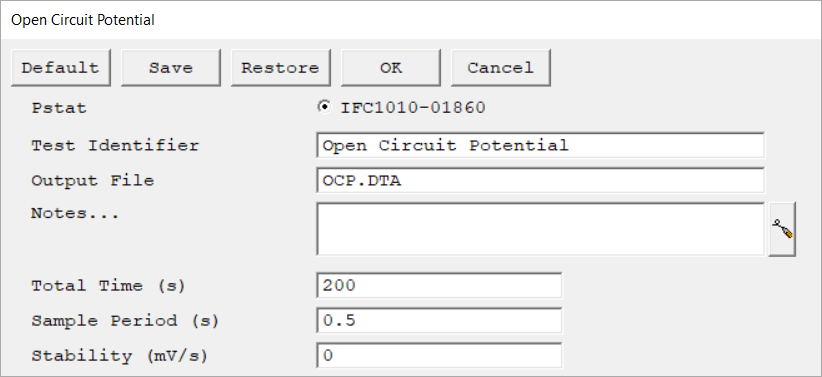Description
Open Circuit Potential is used to measure the open-circuit voltage (Eoc) of an electrochemical cell. Run this utility until the cell becomes stable (when Eoc stops drifting) or for a set amount of time.
You can use the Open Circuit Potential utility regardless of the instrument tier assigned to your Gamry Instruments potentiostat. |
Run this utility by selecting Experiment > Utilities > Open Circuit Potential on the Framework menu bar. The dialog box opens:
Parameter |
Description |
Units |
||
|---|---|---|---|---|
Select the potentiostat/galvanostat to perform the experiment. Each radio button corresponds to an installed potentiostat. You can select only one potentiostat at a time. Potentiostats that are already in use are marked with an asterisk. They can be selected but cannot be used. |
|
|||
A string that is used as a name. It is written to the data file, so it can be used to identify the data in database or data manipulation programs. The Identifier string defaults to a name derived from the technique's name. While this makes an acceptable curve label, it does not generate a unique descriptive label for a data set. The Identifier string is limited to 80 characters. It can include almost any normally printable character. Numbers, upper- and lower-case letters, and the most common punctuation characters including spaces are valid. |
|
|||
The name of the file in which the output data are written. By default, it is saved in the default file directory.
|
|
|||
Enter several lines of text that describe the experiment. A typical use of Notes is to record the experimental conditions for a data set.
Notes defaults to an empty string and is limited to 400 characters. It can include all printable characters including numbers, upper- and lower-case letters, and the most common punctuation including spaces. Tab characters are not allowed in the Notes string. Press the Notes button on the right-hand side to open a separate Notes dialog box. |
|
|||
The duration of the experimental run. The script keeps track of the elapsed time from the start of the experiment. At the start of each test, the elapsed time is compared to the Total Time. If the elapsed time is greater than or equal to the Total Time, the experiment is halted and the Runner window is closed.
|
seconds (s) |
|||
The spacing between data points. The shortest Sample Period we recommend is 0.1 s. The longest Sample Period allowed is 715 s for Reference potentiostats and 750 s for Interface potentiostats.
|
seconds (s) |
|||
Use the Stability parameter to tell the system your definition of a stable potential. If the absolute value of the Eoc drift-rate falls below the Stability parameter, this phase ends immediately, disregarding the Time parameter. The drift rate can never fall below zero, so entering a Stability value of zero ensures that the experiment will not end prematurely.
A typical value is 0.05 mV/s. The lower limit of the Stability parameter is set by your patience. For example, a stability of 0.01 mV/s indicates a drift of less than 1 mV within 100 seconds. |
mV/s |

